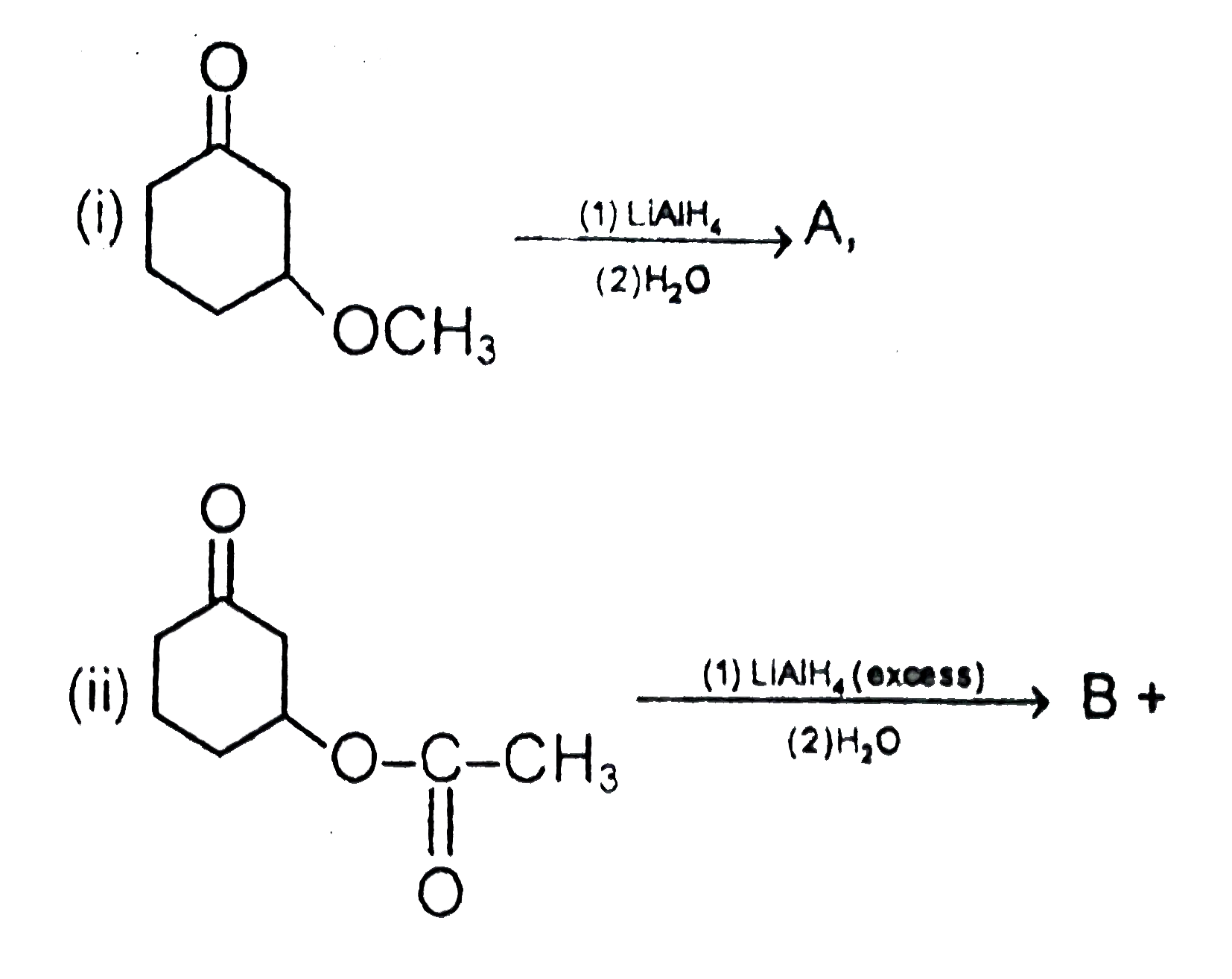An optically inactive amine is methylated with excess of and there after reacted with to form alkene . The alkene B after ozonolysis gives and . A and B in the reaction are respectively.
The correct Answer is:3
To solve the problem, we need to identify the compounds A and B based on the information provided. Here’s a step-by-step breakdown of the solution:
Step 1: Understanding the Reaction
The problem states that an optically inactive amine (A) is methylated with excess of CH₃I. Methylation typically involves the addition of a methyl group to the amine, which can lead to the formation of a quaternary ammonium salt.
Step 2: Identifying Alkene (B)
After methylation, the compound is reacted with AgOH, which suggests a dehydrohalogenation reaction that leads to the formation of an alkene (B). The ozonolysis of alkene (B) gives formaldehyde (HCHO) and butanal (CH₃CH₂CH₂CHO).
Step 3: Analyzing the Ozonolysis Products
The ozonolysis products are HCHO and CH₃CH₂CH₂CHO. The presence of these products indicates that the original alkene (B) must have a structure that, when cleaved, results in these aldehydes.
Step 4: Constructing Alkene (B)
The ozonolysis suggests that alkene (B) is likely 1-pentene (CH₂=CH-CH₂-CH₂-CH₃). This structure, when ozonolyzed, would yield:
- HCHO from the terminal carbon (C1)
- CH₃CH₂CH₂CHO from the other end (C5)
Step 5: Identifying Amine (A)
Since we know that amine (A) is optically inactive, it cannot have a chiral center. The simplest amine that can lead to 1-pentene upon methylation and subsequent reaction with AgOH is butylamine (C₄H₉NH₂).
Conclusion
Thus, the compounds are:
- Compound A (Optically inactive amine): Butylamine (C₄H₉NH₂)
- Compound B (Alkene): 1-Pentene (C₅H₁₀)
Final Answer
A and B in the reaction are respectively:
- A: Butylamine
- B: 1-Pentene
The problem states that an optically inactive amine (A) is methylated with excess of CH₃I. Methylation typically involves the addition of a methyl group to the amine, which can lead to the formation of a quaternary ammonium salt.
After methylation, the compound is reacted with AgOH, which suggests a dehydrohalogenation reaction that leads to the formation of an alkene (B). The ozonolysis of alkene (B) gives formaldehyde (HCHO) and butanal (CH₃CH₂CH₂CHO).
The ozonolysis products are HCHO and CH₃CH₂CH₂CHO. The presence of these products indicates that the original alkene (B) must have a structure that, when cleaved, results in these aldehydes.
The ozonolysis suggests that alkene (B) is likely 1-pentene (CH₂=CH-CH₂-CH₂-CH₃). This structure, when ozonolyzed, would yield:
- HCHO from the terminal carbon (C1)
- CH₃CH₂CH₂CHO from the other end (C5)
Since we know that amine (A) is optically inactive, it cannot have a chiral center. The simplest amine that can lead to 1-pentene upon methylation and subsequent reaction with AgOH is butylamine (C₄H₉NH₂).
Thus, the compounds are:
- Compound A (Optically inactive amine): Butylamine (C₄H₉NH₂)
- Compound B (Alkene): 1-Pentene (C₅H₁₀)
A and B in the reaction are respectively:
- A: Butylamine
- B: 1-Pentene
Topper's Solved these Questions
- BOOK - RESONANCE ENGLISHCHAPTER - NITROGEN CONTAINING COMPOUNDSEXERCISE - ORGANIC CHEMISTRY(Nitrogen containing Compounds)30videos
NITROGEN CONTAINING COMPOUNDS
- BOOK - RESONANCE ENGLISHCHAPTER - NITROGEN & OXYGEN FAMILYEXERCISE - Part-III Practice Test-2 (JEE (Advanced Pattern))23videos
NITROGEN & OXYGEN FAMILY
- BOOK - RESONANCE ENGLISHCHAPTER - NUCLEAR CHEMISTRYEXERCISE - STAGE-II1videos
NUCLEAR CHEMISTRY
Similar Questions

CH3−CH2−OH
In the given reaction A & B are respectively:View SolutionThe olefin which on ozonolysis gives CH3CH2CHO and CH3CHO is
View SolutionGive IUPAC name of : OH−CH3−CH2−CH2−CHO
View SolutionGive IUPAC name of : I−CH2−CH2−CH2−CHO .
View SolutionWhich alkene on ozonolysis gives CH3CH2CHO and CH3C∣∣OCH3 ?
View SolutionWhich alkene on ozonolysis gives CH3CH2CHO and CH3C∣∣OCH3 ?
View SolutionAn alkene on reductive ozonolysis gives two molecules of CH2(CHO)2. The alkene is:
View SolutionCH3CHO+LiAlH4→CH3CH2OH Nucleophile added in this reaction is
View SolutionGive the IUPAC names of the following compounds :
CH3CH(CH3)CH2CH2CHOView SolutionGive the IUPAC names of the following compounds :
CH3CH(CH3)CH2CH2CHOView Solution

